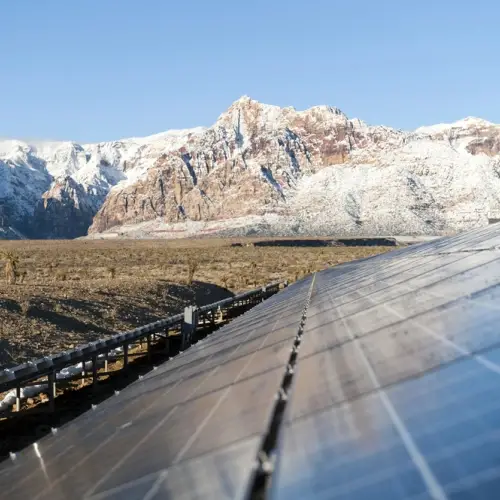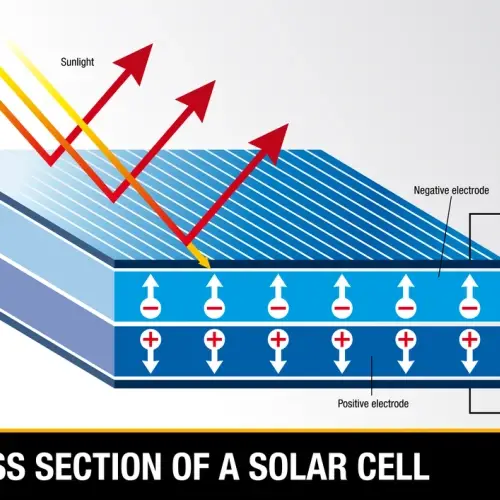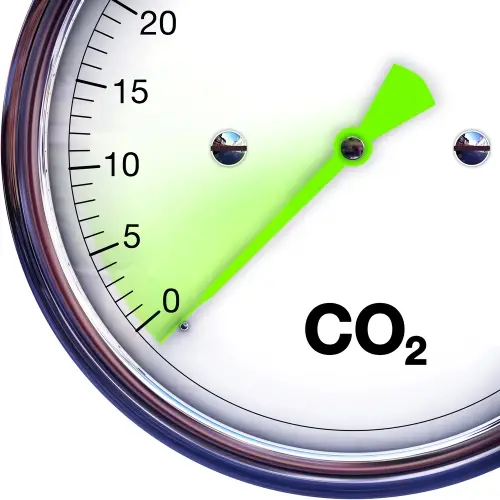
Photovoltaic energy is a form of renewable energy obtained from solar radiation and converted into electricity through the use of photovoltaic cells. These cells, usually made of semiconductor materials such as silicon, capture photons of sunlight and generate electric current.
The electrical generation process of a photovoltaic system begins with solar panels , which consist of multiple photovoltaic cells connected in series or parallel. When sunlight hits the cells, electrons in the semiconductor material become excited and move, creating a direct electric current.
This current is collected and sent through wires to an inverter, which converts the direct current into alternating current , which is the form of electricity used in homes and industry.
Definition of photovoltaic energy
 Photovoltaic energy is a form of renewable energy that converts sunlight into electricity through the photovoltaic effect. This process occurs in photovoltaic cells, usually made of semiconductor materials such as silicon, which generate an electric current when exposed to solar radiation.
Photovoltaic energy is a form of renewable energy that converts sunlight into electricity through the photovoltaic effect. This process occurs in photovoltaic cells, usually made of semiconductor materials such as silicon, which generate an electric current when exposed to solar radiation.
This technology is used in distributed generation systems, such as solar panels on homes, and in large-scale solar plants to supply the electricity grid. Its main advantage is that it takes advantage of an inexhaustible source of energy without generating polluting emissions, which makes it a sustainable alternative to fossil fuels.
How does photovoltaic energy work?
 Solar photovoltaics work by directly converting sunlight into electricity through the photovoltaic effect. This process occurs in photovoltaic cells, usually made of silicon, a semiconductor material. When sunlight hits these cells, the photons transfer their energy to the electrons in the material, generating a direct electric current.
Solar photovoltaics work by directly converting sunlight into electricity through the photovoltaic effect. This process occurs in photovoltaic cells, usually made of silicon, a semiconductor material. When sunlight hits these cells, the photons transfer their energy to the electrons in the material, generating a direct electric current.
For use in domestic and industrial applications, the electricity generated is channeled to an inverter, which converts the direct current into alternating current, compatible with the electrical grid and electrical devices.
Depending on the system, energy can be consumed at the time, stored in batteries or fed into the grid. Being a renewable and clean source, photovoltaic energy is a sustainable alternative to fossil fuels.
Components of a photovoltaic installation
A photovoltaic system consists of several components that work together to convert solar radiation into usable electricity.
Here's how a basic solar PV system works:
Solar panels
Solar panels, also known as photovoltaic panels, are composed of photovoltaic cells containing semiconductor materials, usually silicon. When photons of sunlight strike the cells, they excite electrons in the semiconductor material and generate a direct electric current.
Wiring and connections
Solar panels are connected in series or parallel to increase current or voltage as needed. Electrical cables and special connectors are used to interconnect the panels and create a solar array.
Power inverter
The electric current generated by solar panels is direct current (DC), but most appliances and the power grid use alternating current (AC). Therefore, an inverter is used to convert direct current to alternating current. The power inverter also controls and monitors the performance of the system.
Bi-directional meter and grid connection system (if applicable)
In some photovoltaic systems, especially those connected to the grid, a bi-directional meter is used to measure the amount of electricity generated and the amount of electricity consumed. If the system is connected to the grid, excess electricity generated can be sent to the grid, and the meter records this additional production.
Batteries (optional)
Some solar installations include batteries to store excess electricity generated during the day and use it at night or during times of low solar radiation.
Batteries allow for energy self-sufficiency and the use of generated electricity even when sunlight is not available.
Advantages of photovoltaic energy
Photovoltaic systems offer several advantages compared to other energy sources. Here are some of the main advantages of this technology:
-
Renewable and sustainable energy: Photovoltaic energy is based on solar radiation, an inexhaustible source of energy. Unlike fossil fuels, whose availability is limited and contributes to the depletion of natural resources, solar energy is a sustainable option in the long term.
-
 Zero emissions and environmentally friendly: During the generation of electricity using solar panels, no greenhouse gas emissions or pollutants are released into the environment. This contributes to reducing the carbon footprint and mitigating climate change.
Zero emissions and environmentally friendly: During the generation of electricity using solar panels, no greenhouse gas emissions or pollutants are released into the environment. This contributes to reducing the carbon footprint and mitigating climate change. -
Long-term cost savings: Once installed, a photovoltaic system can generate electricity for free from the sun. This can reduce or even eliminate dependence on the conventional power grid and lower energy costs in the long run.
-
Energy independence: Installing solar panels allows users to generate their own electricity. This provides energy independence and reduces vulnerability to potential power outages.
-
Wide applicability and scalability: Photovoltaic systems can be adapted to different needs and scales, from residential installations to large-scale projects.
-
Low maintenance: Solar panels require minimal maintenance. Generally, they only need to be cleaned periodically to ensure that solar radiation is transmitted efficiently.
-
Distributed generation: Photovoltaic systems can be installed in areas close to the point of consumption, which reduces electricity transmission and distribution losses, optimizes efficiency and contributes to the stability of the electrical grid.
Countries with the highest production of photovoltaic energy
The share of electricity generated by solar photovoltaics worldwide has seen significant growth in recent years. According to data from the International Renewable Energy Agency (IRENA), by the end of 2020, the global installed capacity of solar photovoltaic energy reached 773 gigawatts (GW).
According to the International Energy Agency (IEA) Renewables 2021 report, in 2020, solar photovoltaics were responsible for around 3% of global electricity generation worldwide.
Below is a table showing some of the top countries in terms of photovoltaic power generation in 2022.
|
Country |
Installed capacity of photovoltaic energy (GW) |
Percentage of solar power compared to other energy sources |
|
China |
252 |
12.7% |
|
USA |
110 |
3.4% |
|
Japan |
67 |
9.7% |
|
Germany |
52 |
11.8% |
|
India |
45 |
4.2% |
|
Australia |
20 |
7.3% |
|
South Korea |
16 |
2.9% |
|
France |
12 |
2.7% |
|
Italy |
20 |
8.6% |
|
Spain |
10 |
7.3% |
Efficiency of photovoltaic panels
Currently, the best conversion rate of sunlight into electricity is about 21.5%.
Depending on the construction, photovoltaic panels can produce electricity from a specific range of light frequencies. However, in general they cannot cover the entire solar range. In particular, photovoltaic cells cannot convert ultraviolet , infrared and low or scattered light into electricity.
One way to increase the efficiency of solar panels would be to illuminate them with monochromatic light; much higher efficiencies could be obtained.
Another design concept is to split the light into different wavelengths. Once separated, they are directed towards different cells tuned to these ranges. Such an installation is capable of increasing electrical efficiency by 50%.
Examples of uses and applications
The purpose of photovoltaic systems is to produce electricity that can be used in multiple applications. Below are some examples:
-
Large-scale power generation. There are large power plants connected directly to the grid that can generate hundreds of megawatts. However, these solar farms are built using solar concentrators and operate like a thermal power plant.
-
Systems integrated into roofs and buildings: These systems can be for self-consumption of electricity but can also be connected to the public grid.
-
Rural electrification. This type of solar application is used in rural villages where power lines are far from the population.
-
Street and road lighting.
-
Stand-alone systems for powering small devices such as calculators, solar mobile chargers, etc.
-
In transportation: some electric vehicles have integrated solar systems to power an electric motor and obtain driving power.
-
Communications and signaling towers that use electrical devices that do not consume large amounts of electrical energy and that are difficult to connect to the electrical distribution network.
-
Use in spacecraft and space stations since available energy sources in space are scarce.
-
Water pumping systems.
Types of photovoltaic installations
Photovoltaic installations are divided into two main categories according to their relationship with the electrical grid:
Systems connected to the public electricity grid
These photovoltaic systems are connected to the public power grid. In this approach, solar panels generate electricity when sunlight is available. If electricity production exceeds local demand at the time, the excess is fed into the power grid. In return, the system owner can receive credits or compensation for the electricity generated, often referred to as “net metering.”
This approach is common in urban and commercial areas and can include large photovoltaic plants or solar parks that generate electricity on a large scale.
Off-grid systems
Off-grid systems are independent of the public power grid and are used for self-consumption in locations that do not have access to the power grid or in specific applications. These systems generate electricity from solar energy and store it in batteries for later use.
They are used in isolated homes, remote weather stations, road lighting in rural areas or remote locations, and in situations where it is not possible or cost effective to connect to the conventional power grid.